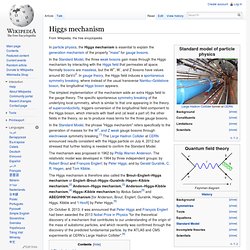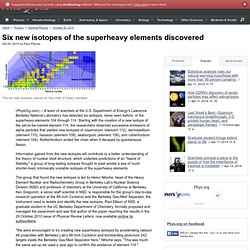

Higgs mechanism. In particle physics, the Higgs mechanism is essential to explain the generation mechanism of the property "mass" for gauge bosons.

In the Standard Model, the three weak bosons gain mass through the Higgs mechanism by interacting with the Higgs field that permeates all space. Normally bosons are massless, but the W+, W-, and Z bosons have values around 80 GeV/c2. In gauge theory, the Higgs field induces a spontaneous symmetry breaking, where instead of the usual transverse Nambu–Goldstone boson, the longitudinal Higgs boson appears. The simplest implementation of the mechanism adds an extra Higgs field to the gauge theory. The specific spontaneous symmetry breaking of the underlying local symmetry, which is similar to that one appearing in the theory of superconductivity, triggers conversion of the longitudinal field component to the Higgs boson, which interacts with itself and (at least a part of) the other fields in the theory, so as to produce mass terms for the three gauge bosons.
List of particles. This is a list of the different types of particles found or believed to exist in the whole of the universe.

For individual lists of the different particles, see the individual pages given below. Elementary particles[edit] Fermions[edit] Fermions are one of the two fundamental classes of particles, the other being bosons. Fermion particles are described by Fermi–Dirac statistics and have quantum numbers described by the Pauli exclusion principle. Fermions have half-integer spin; for all known elementary fermions this is 1⁄2. Quarks[edit] Leptons[edit] Bosons[edit] Bosons are one of the two fundamental classes of particles, the other being fermions. The fundamental forces of nature are mediated by gauge bosons, and mass is believed to be created by the Higgs Field. The graviton is added to the list[citation needed] although it is not predicted by the Standard Model, but by other theories in the framework of quantum field theory. Hypothetical particles[edit] Composite particles[edit] Mesons[edit]
Matter vs. Antimatter. Standard Model. Quantum Theory. New kind of light created in physics breakthrough. Physicists have created a new kind of light by chilling photons into a blob state.

Just like solids, liquids and gases, this recently discovered condition represents a state of matter. Called a Bose-Einstein condensate, it was created in 1995 with super-cold atoms of a gas, but scientists had thought it could not be done with photons, which are basic units of light. However, physicists Jan Klärs, Julian Schmitt, Frank Vewinger and Martin Weitz of the University of Bonn in Germany reported accomplishing it. They have dubbed the new particles "super photons. " Particles in a traditional Bose-Einstein condensate are cooled down close to absolute zero, until they glom onto each other and become indistinguishable, acting as one giant particle. The scientists needed to find a way to cool the photons without decreasing their numbers. "Many scientists believed that it would not be possible, but I was pretty sure that it would work," Weitz told LiveScience.
Related on LiveScience: Six new isotopes of the superheavy elements discovered. (PhysOrg.com) -- A team of scientists at the U.S.

Department of Energy's Lawrence Berkeley National Laboratory has detected six isotopes, never seen before, of the superheavy elements 104 through 114. Starting with the creation of a new isotope of the yet-to-be-named element 114, the researchers observed successive emissions of alpha particles that yielded new isotopes of copernicium (element 112), darmstadtium (element 110), hassium (element 108), seaborgium (element 106), and rutherfordium (element 104). Rutherfordium ended the chain when it decayed by spontaneous fission. Information gained from the new isotopes will contribute to a better understanding of the theory of nuclear shell structure, which underlies predictions of an "Island of Stability," a group of long-lasting isotopes thought to exist amidst a sea of much shorter-lived, intrinsically unstable isotopes of the superheavy elements.
The nuclear shell game A new strategy.